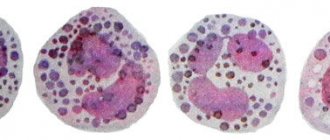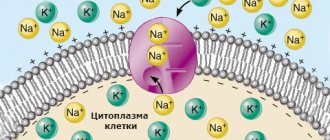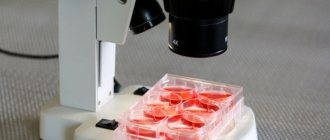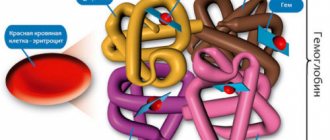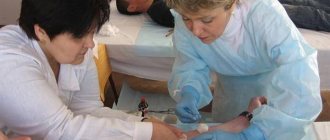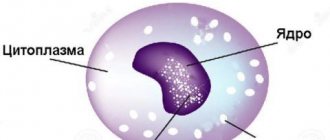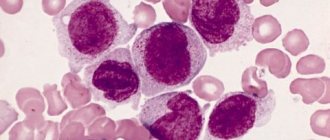The designation GRA in a blood test refers to cells such as granulocytes. These are components of liquid connective tissue related to leukocytes. It is important to know that GRA in a blood test are cells whose presence is normal. But both an increase and a decrease in the level of granulocytes may indicate the development of a pathological process in the body. Indications for analysis, features of preparation for the study, interpretation of the obtained values and treatment are described below.
Granulocytes (GRA, GRAN) in general analysis
A general blood test is the most common, simple and effective way to determine a person’s health status. To carry out such an analysis, no special preparation or even a specific diet is required. Everything is much simpler and faster compared to many other medical procedures.
It is worth noting that a general blood test can be performed on both adults and children. Therefore, even here there are no restrictions. For such a study, the patient’s regular capillary blood is most often taken from a finger. In some cases it is possible from a vein. There is no particular difference in this, only that venous blood can give the most accurate results of the content of certain components.
It is recommended to donate blood on an empty stomach in the morning, since it is at this moment that it is clearer of all possible other components that could be caused by food or other conditions. For example, this could be strenuous physical activity, the menstrual cycle in women, pregnancy and some other chronic diseases. Therefore, when presenting the results of the study, the doctor needs to be told about the possible reasons for the changes.
How is blood drawn?
A complete blood count is usually performed early in the morning, on an empty stomach or 7-8 hours after eating. It is taken, as a rule, from a finger, less often from a vein. Next, the blood is sent to the laboratory for analysis. A general blood test is needed in many cases both to check for the presence of any disease and to prevent various diseases. The response form arrives within 2-3 days. Some indicators can be determined independently, but many of them require the opinion of a specialist who will compare all the facts and say whether this is normal.
There are several factors to consider before drawing blood. For example, it is not advisable to go to a girl during menstruation, as it may interfere with determining the accuracy of the results. Frequent physical activity can also interfere with this. This is especially true for athletes. Therefore, 2 days before donating blood, it is important to reduce physical activity or, if possible, stop training altogether.
Also, do not forget that you should not take alcoholic beverages, which will completely disrupt the accuracy of the results and cause irreparable damage to the condition of the blood. Therefore, three days before the analysis, you need to completely limit yourself to alcoholic beverages and replace them, for example, with juice or another non-alcoholic drink.
It is advisable to do without much mental stress, since stress increases certain substances in the body, which will also bring down some indicators, maybe even for the worse.
Why is a general blood test performed?
This blood test is a fairly extensive study, therefore it includes quite a lot of indicators:
- determination of the number of red blood cells;
- blood hemoglobin level;
- total number of leukocytes and determination of the leukocyte formula;
- presence of platelets in acceptable limits;
- hematocrit decoding;
- calculation of erythrocyte sedimentation rate - ESR.
The above components of the general analysis are the most common and enable the doctor to immediately determine whether the patient has a problem. In some other cases, the patient is prescribed a more detailed and thorough examination to identify a more complex and serious disease.
Specific Ingredients
We will talk directly about such a component of blood as the GRA indicator. In medicine, this designation occurs to characterize granulocytes. In laboratory studies, they appear in the form of granular leukocytes, whose main job is to fight infections, various inflammations and allergies.
Various deviations from the norm indicate that some kind of inflammation is occurring in the body or that slightly other infectious problems are present. There are three types of granulocytes known in medicine: eosinophils, basophils and neutrophils. Basophils, in turn, consist of their oxidase, fat, peroxidase, histamine and heparin. Such enzymes take part in determining disorders of vascular permeability and various allergic diseases.
Neutrophils make up the bulk of leukocytes, the main function of which is the production of enzymes that are responsible for the bactericidal functions of the blood. In this case, it has up to 35 different types of enzymes.
An inflammatory process in the body or the first response of the immune system to the appearance of an infection can be suspected when the level of immature granulocytes in the blood increases: https://krasnayakrov.ru/analizy-krovi/nezrelyie-granulotsityi-v-analize-krovi-vazhnyiy.html
And finally, eosinophils, which perform their functionality directly in the tissues of the body. Such cells contain iron, lipids, histamine, proteins, phosphorus, RNA and some other enzymes useful for the functioning of the body.
This characteristic of blood has been known for quite a long time and today is popular in medicine. This is especially true for routine examination of the patient or, if necessary, to determine the nature of the disease in the shortest possible time.
Normal limits
Regardless of a person’s age, the GRA blood indicator has its own specific normal limits.
The actual decoding takes place in the laboratory, and the doctor is provided with ready-made results, measured as a percentage. Therefore, results can be considered normal in the range from 47% to 72%. Other deviations will indicate that some disturbances are occurring in the body, which in particular led to similar results. If we consider in absolute ratios, then the decoding of the permissible norm will range from 1.2 to 6.8x(10^9)/l. In any case, you should not ignore the negative results of the study, as this can lead to significant consequences .
It is better to immediately show your blood test to a doctor and consult with further actions. You may need appropriate treatment or a repeat blood test now to confirm the results provided. Perhaps this was false information and will not be confirmed again.
Why not the norm?
Quite often, a general blood test does not come back ideal. And the reason for this can be a variety of situations. For example, the GRA indicator in a blood test can be either increased or decreased. The main thing is only in such cases to know what could have provoked such a result. Thus, an increase in the analysis will indicate the presence of an inflammatory process in the body. This can be a variety of diseases that lead to changes in blood composition.
As for the directly reduced results, we can talk about the presence of some autoimmune diseases. For example, it could be diabetes mellitus, toxic goiter, rheumatoid arthritis and some others.
The main reasons for the decrease in granulocytes in the blood
Granulocytes are white blood cells that contain granularity - small granules filled with active biological substances. They are formed in the bone marrow from the granulocytic germ of hematopoiesis and are represented by three types of cells: neutrophils, eosinophils, basophils.
Leukocytes are determined by studying a general blood test, which is the most common laboratory test in medical practice.
The study results often show decreased granulocytes, which indicates a pathological process in the body and requires specific treatment.
The essence and objectives of analysis on GRA
A general blood test is considered the most accessible method to simultaneously establish several parameters that determine the condition of the body.
Deciphering the general analysis allows you to detect deviations in the functional processes of organs and diagnose the disease.
One of the components of the analysis is a blood test for GRA - granulocytes, a type of white blood cell.
Granulocytes, along with other blood cells, perform important functions on which the performance of the body as a whole depends.
In particular, granulocytes perform a protective mission, ensuring the fight against problems of an inflammatory, infectious or allergic nature.
Accordingly, the GRA indicator, determined as part of the procedure, makes it possible to find out how intense the protective processes are, as well as to determine the presence of pathological sources.
Granulocytes are a type of leukocyte that consists of granules. Granulocytes are often also called granular leukocytes.
A complete blood count involves examining three types of granulocytes - eosinophils, basophils and neutrophils.
The granulocyte series is considered the body's first line of defense, since its components are the first to respond to the invasion of harmful microorganisms and provide the body's immune response.
In relation to the total number of leukocytes in the blood, granulocytes occupy up to 75%. Each of the GRA subtypes has specific properties and performs specific tasks of cellular immunity.
Different granulocytes react to different pathogens of pathological processes, but their functions are not performed separately, but together with other representatives of white blood cells.
When pathological processes in the body become excessively intense, all blood neutrophils are involved to ensure and support protective functions.
As a result, the white cells exhaust their potential and die within a day or two.
To eliminate the cell deficiency, immature granulocytes, but capable of maintaining protection, appear in the blood.
A general blood test allows you to detect immature white cells and draw conclusions about the level of inflammatory processes in the body.
The percentage GRA is the ratio between granulosa cells and the total number of leukocytes.
The numerical GRA indicator is determined by subtracting lymphocytes and monocytes from the total number of leukocytes, which is reflected in the analysis transcript.
Granulocytes are reduced: what does this mean, reasons
If, as a result of examining a blood sample, it turns out that granulocytes are low, then this should be regarded as a deviation from the norm, which indicates the presence of pathologies.
Let's try to figure out what are the reasons for their appearance.
Types and functions of blood cells
Granulocytes are white blood cells, a type of leukocyte. Under a microscope, it can be seen that the structure of these cells is similar to grains or granules - hence the name.
The main center for the production of all types of leukocytes is the bone marrow, and their main purpose is to protect the body from external and internal pathogens.
Although white blood cells are considered blood cells, they are able to leave the bloodstream by penetrating through capillary walls into the spaces between other cellular particles in the body.
Some types of white cells have the ability to absorb foreign bodies - this process is called phagocytosis in medicine.
In confrontation with foreign elements, white blood cells die, but new ones immediately rush to their place, produced by the bone marrow and stored there until a certain moment, as in a warehouse.
There are two types of white blood cells - the granular type, known as granulocytes, and the non-granular type, known as agranulocytes.
The bloodstream of a healthy person contains a certain amount of each type of cell; any deviations from the norm are considered as a sign of unhealthy processes and require medical intervention.
In relation to other types of leukocytes, granulocytes are the most numerous and make up up to 80 percent. In the results of a blood test, the quantitative composition of white cells is indicated in the leukocyte formula.
There are three types of granulocytic type cells:
- neutrophilic;
- eosinophilic;
- basophilic.
Neutrophil granulocytes are segmented or band cells, the main type of leukocytes in human blood.
Neutrophils are called segmented because their nucleus is divided into several segments.
The task of these cells is to perform an antimicrobial function in the body, neutralizing bacteria and fungi through phagocytosis (absorption).
READ Can a blood test show pneumonia?
Exceptions include expectant mothers and newborn children, for whom the presence of immature neutrophils in the blood is considered normal.
In newborns, high levels of band granulocytes can persist for up to a year.
:
An increase in the number of immature cells indicates depletion of cell mass reserves, which occurs during intense inflammatory processes. A low level of neutrophil granulocytes is called neutropenia.
Eosinophils are granulocytes with a bilobed nucleus. Moving towards the affected inflamed tissues, eosinophil cells actively participate in antiparasitic immunity, ensuring the maintenance of immediate allergic reactions and absorbing foreign particles. Low levels of eosinophils are called eosinophilia.
Basophils are a subtype of granulocytes with large nuclei. The mission of these cells is to maintain immediate allergic reactions and participate in blood clotting processes. A decrease in the level of basophils in the blood is called basopenia.
Reasons for the decrease in eosinophilic and basophilic granulocytes
When the results of a blood test show a decrease in granulocytes, it is difficult to understand what this means without medical education. You need to know what analysis indicators are considered normal.
Quantitative norms of granulocyte cells in the blood are designated using the abbreviation GRA and are indicated either as a percentage of the total number of leukocytes (GRA%) or as an absolute indicator (GRA #).
Accordingly, when deciphering the results of the analysis, doctors are guided by this normal indicator - 1.2 - 6.8 * 10⁹ per liter of blood or 47 - 72 GRA% of the total level of leukocytes.
The results of the analysis indicate the number of immature granulocytes. The normal level of indicators of such cells can range from 1 to 5 percent.
:
For each type of granulocytes, there are normal indicators established by medicine.
Reduced granulocytes cannot be regarded as evidence of any one disease. The diagnosis may differ depending on which subtype the indicators are not normal.
READ What is the HbsAg indicator in a blood test?
A decrease in the level of eosinophilic granulocytes (eosinopenia) is diagnosed when the number of cells is less than 5*10⁴/ml, which may indicate:
- septic condition;
- acute form of bacterial infection;
- physical overload;
- burn disease;
- anemia due to folate deficiency;
- side effects of glucocorticoids;
- as a result of a stressful situation;
- numerous injuries;
- hypoplastic anemia;
- post-surgical intervention.
In children, a decrease in eosinophil cells is considered a sign of pathological processes in the hematopoietic system.
Basophils are considered the largest granulocytes, the functionality of which is determined by the presence of prostaglandins, histamine and serotonin in their composition, and the ability to produce heparin, which regulates blood clotting.
Basophil activity increases as soon as any toxins enter the body.
Even when bitten by bees or poisonous snakes, basophilic granulocytes not only block the action of the poison, but also remove toxic substances from the body.
A decrease in the level of basophils in the blood (basopenia) is not only a rare phenomenon, but also difficult to diagnose. A deviation from the norm is considered to be a decrease in values from 0.01*10⁹/l.
In most cases, a decrease in the level of basophils is a consequence of insufficient functionality of the hematopoietic system.
Most often, basopenia develops against the background of such pathologies as:
- pneumonia;
- infections;
- pathologies of the endocrine system - Graves' disease, hyperthyroidism;
- Cushing's syndrome.
In addition, basophils decrease as a result of stressful situations, after taking hormonal anti-inflammatory drugs, as a result of chemotherapy, in women - during ovulation and during pregnancy.
Reasons for the decrease in neutrophil granulocytes
Typically, granulocyte levels change throughout a person's life. Indicators in an adult differ from the level of white cells in children under one year old.
If the granulocyte counts are lower than normal, then the doctor’s task is to determine the cause of the pathology and eliminate it by prescribing a course of treatment.
Neutrophil granulocytes mature in the bone marrow. This period takes an average of 10 days, and then the cells enter the bloodstream and perform their protective functions for 10 hours. The highest concentration of neutrophils is observed in the affected tissues.
A decrease in the level of neutrophil cells (neutropenia) can be a symptom of the following human pathological conditions:
- radiation injury;
- neoplasms in the bone marrow - leukemia, myelofibrosis;
- various types of anemia;
- typhoid fever;
- diabetes mellitus;
- toxic goiter;
- malaria;
- bacterial infections - brucellosis, tularemia;
- viral infections - influenza, rubella, various subtypes of hepatitis, AIDS;
- autoimmune pathological conditions - collagenosis, lupus erythematosus;
- depletion of the biological potential of the body against the background of chronic alcoholism, cachexia;
- hypersplenism;
- taking medications with toxic effects - tranquilizers, antibiotics, immunosuppressants;
Neutrophils may be low in a child with congenital Kostman syndrome. As a result of the development of this pathology, the bone marrow loses the ability to produce the required number of neutrophils.
The consequences of the disease are more than serious - a general weakening of cellular immunity is accompanied by multiple inflammatory lesions of the skin and internal organs, which often leads to death.
The degree of development of neutropenia is reflected in the results of a blood test as follows:
- mild form - the number of neutrophils is from 1*10⁶/ml;
- severe form - the number of neutrophils is less than 5*10⁵/ml.
To make an accurate diagnosis, it is very important to know the degree of relationship between mature and immature forms of granulocytes. Autoimmune diseases and congenital forms of leukopenia can reduce the levels of immature white cells.
A decrease in granulocytes against the background of an increase in the number of leukocytes is always a symptom of intense inflammatory processes.
:
In addition, granulocyte counts often change during the summer. Summer is the time of activity of allergens, bacteria and fungi, the damage to which is reflected in a blood test.
In children under one year old, the rate of immature granulocytes cannot exceed 4%, from one year to 6 years - 5%, upon reaching 15 years - no more than 1 - 5%.
Any pathologies that occur in the body require medical supervision and accurate diagnostic conclusions, therefore, even understanding the meaning of granulocyte indicators, you should not self-medicate.
Are you here:
17740 0
Source: https://moydiagnos.ru/analizi/krovi/granulotsity-ponizheny.html
Features of GRA analysis
Given that the GRA test is performed as part of a general clinical blood test, it is carried out in a standard manner.
The material for the study is taken from a finger in a regular clinic. No additional manipulations are required when collecting blood, but a little preparation is welcome.
In order for a general blood test to show objective results, it is necessary to eliminate factors that can change the blood formula.
These factors include:
- alcohol;
- fatty and heavy food for the stomach;
- smoking;
- physical and mental stress;
- other diagnostic procedures - x-ray, MRI, fluorography;
- medications;
- for women - the period of menstruation.
Also an important condition for a successful study is the correct diet on the day of the procedure. Doctors recommend refraining from a large breakfast, replacing it with light unsweetened porridge with water or an apple.
You are only allowed to drink unsweetened tea or water. After the analysis, you can return to your normal lifestyle.
The level of granulocytes in the blood depends on the activity of the bone marrow, which is responsible for their production.
There is a standard that determines GRA indicators for patients depending on gender and age. This norm differs in adults and children at different periods of life.
For adults, the norm for mature granulocytes is 45–70%, and the level of immature cells can range from 1 to 5%.
Comparison of standard indicators and those obtained after the study makes it possible to understand the nature of the deviations, and decoding the results of the analysis helps to draw preliminary diagnostic conclusions.
GRA in blood test: normal values
Only a doctor can correctly decipher the result of the study. This is due to the fact that based on an increase or decrease in the number of any cells, it cannot be guaranteed that there is a pathology. If the development of the disease is suspected, it is necessary to conduct a comprehensive diagnosis. With the help of analysis, it is only possible to suspect the course of the pathological process.
It is important to understand that granulocytes are cells that must be present in the body of every person. Normal indicators directly depend on a person’s age:
- 12 months - 31%;
- up to 10 years - 51-53%;
- 10-16 years old - 53-57%;
- 16-21 years old - 59%.
In newly born children, the granulocyte level should be 35%. In adult women and men, the normal rate is 47-72%. Some laboratories use other units of measurement. In adults, the norm of granulocytes is 1.2-6.8 x 109 (in 1 liter of blood).
It is important to remember that granulocytes are a group of cells that includes several functional units. When decoding the study, it is necessary to pay attention to their indicators.
GRA norm in blood test:
- Basophils. In children under 12 months, their level should be at least 0.4% and no more than 0.9%. In adolescents and adults, the normal rate is 0.6-1%.
- Eosinophils. The level of these cells directly depends on the degree of functioning of the adrenal glands. The norm is 120-350 (in 1 ml of blood). In the morning their level can be increased by 15%, at night (in the first half) - up to 30%.
- Neutrophils. These cells are divided into rod and segmented. The number of the former should not exceed 6%. The norm for segmented neutrophils is 40-70%.
As a rule, if granulocytes are increased or decreased, this means that a pathological process is developing in the body. However, sometimes deviations from the norm can occur for physiological reasons. In women, granulocytes are elevated before menstrual bleeding, in the third trimester of pregnancy and during the delivery process. In both sexes, deviations from the norm to a greater extent may be a consequence of overeating and high-intensity physical activity.
The presence of immature granulocytes in the blood is not a pathology. This is explained by the fact that the life cycle of granular leukocytes is only a few days. In other words, the change to young cells occurs very quickly, the number of the latter ranges from 1 to 5%.
Specifics of GRA analysis in children
A general blood test in children follows the same principles as the procedure for adults. However, the norm that guides the decoding of the analysis results is different.
The standard granulocyte count for children is slightly lower than for adults. This is explained by the fact that the number of white blood cells is usually lower in a child.
Immature granulocytes mature quite quickly, so their number in both adults and children is small and amounts to no more than 5% of the total number of leukocytes.
The lowest GRA rates are observed in children under one year of age - up to 30% mature neutrophils and up to 4% immature.
What is it and what are its functions?
Granulocytes are granular white blood cells. Their peculiarity is the presence of two nuclei at once, the shape of which is irregular. Their nuclei, in turn, are also divided into several lobules. Also in their cytoplasm there are specific granules that are clearly visible under a light microscope.
This type of leukocyte is formed in the bone marrow. Granulocytes make up about 50-80 percent of all white blood cells.
These cells are our body's first line of defense against microbes. Granulocytes are the very first to note disorder and move towards the site of inflammation . Granulocytes also help to implement the immune response of our body, more precisely, its effector phase. Thus, their main function is the correction of immunity. But since there are several types, each type has different functions.
Visually about granulocytes in the video below
They are easy to find in a blood test: in the leukocyte formula, and they are divided into eosinophils, neutrophils and basophils. In a general blood test, the norm for all granulocytes does not have a separate designation , but the 50-80 percent mentioned above means that there are from 2.5 thousand to 7 thousand of them in one milliliter of blood. In this case, eosinophils should be from one to five percent of the total number, basophils - up to one percent, and neutrophils - from 40 to 70%.
Their number can be calculated using a simple formula:
Anna Poniaeva. Graduated from the Nizhny Novgorod Medical Academy (2007-2014) and Residency in Clinical Laboratory Diagnostics (2014-2016).Ask a question>>
The total number of white blood cells minus the sum of monocytes and lymphocytes.
In different blood tests, the number of these cells can be expressed either as GRA%, that is, a percentage of the total number of white cells, or as an absolute indicator, that is, GRA#.
- Neutrophils are one of the most numerous groups: from 50 to 80 percent of the total number of leukocytes. They can be either segmented or rod-shaped. In the former, the nucleus is small and divided into lobes, and there is a lot of cytoplasm. Band neutrophils are a younger form of neutrophils, and in children under one year old their percentage can be approximately, and this is the norm. The main task of neutrophils is phagocytosis, that is, they search for, capture and digest bacteria, tumors and viruses. Also, many components of neutrophils are an important component of immunity (cellular);
- Eosinophils . Their number among all leukocytes ranges from one to five percent. Their nucleus is also large, and there are fewer segments in it than in neutrophil nuclei. Their task is phagocytosis and maintenance of an allergic reaction of the anaphylactic type (immediate).
- Basophils . Small cells with large nuclei and little cytoplasm. Their task is to actively participate in anaphylactic-type reactions, create allergic reactions and fight inflammation.
Below are two videos about neutrophils and eosinophils with their visual representation
Decoding the analysis on GRA
Deviations of GRA indicators from the norm indicate changes in the body. Deciphering the research results helps to understand the nature of these deviations.
If the study shows that the GRA level is elevated, then this may be a symptom:
- pneumonia, meningitis, thrombophlebitis, otitis, pyelonephritis, appendicitis;
- purulent processes;
- typhoid fever, tuberculosis, influenza, rubella, hepatitis;
- dermatitis;
- burns or bleeding;
- lead intoxication;
- heart attack;
- helminthic infestations;
- excess of glucocorticosteroids.
An increase in GRA is also possible after a heavy meal, under the influence of physical activity, against the background of hormonal activity - during menstruation, during pregnancy.
If the results of the study were lowered, then there are reasons to suspect:
- autoimmune diseases - diabetes, goiter, rheumatoid arthritis;
- hematological pathologies;
- collagenoses;
- viral infections.
Along with other indicators examined during a general blood test, the GRA value provides a unique opportunity to assess the level of the body’s defenses, and at the same time helps to timely diagnose inflammatory processes, the hidden nature of which can seriously affect the functionality of the body.
Indications for the study
GRA are formed elements of liquid connective tissue that represent the body's defense system. In a blood test, granulocytes are found in a certain quantity, a deviation from which indicates a pathological process occurring in the human body.
The main indication for a clinical study of liquid connective tissue is:
- assessment of the state of the body's defense system;
- obtaining information about the cause of the disease state;
- identification of bacterial inflammatory process;
- determination of immune load;
- tracking the progress of recovery.
Decoding the abbreviation
Gran (GRA) - granulocytes or granular leukocytes. It is their graininess that gives them their name. What are leukocytes? These are white blood cells, the level of which in the blood is stable. If there are deviations from the norm, doctors may suspect the development of a particular disease in the body.
Granulocytes include 3 types of leukocytes:
- Neutrophils. In terms of numbers, this is the largest group of leukocytes. Neutrophils are responsible for fighting pathogenic bacteria. They absorb harmful cells and break them down. After this, the neutrophil dies. These cells have six stages of maturity. Stages 1 and 2 are a state of rest when nothing threatens the body. The remaining 4 stages indicate the presence of infection. It is at these stages that doctors assess the condition of the body.
- Eosinophils. These cells are synthesized in the bone marrow. After maturation, they enter the bloodstream, where they search for foreign proteins. Having found such a molecule, the eosinophil absorbs it and dissolves it.
- Basophils. These cells are aimed at fighting allergens. When it encounters an allergen, the basophil is destroyed and releases a specific compound into the blood, by the amount of which in the blood doctors can judge the presence of the disease. Basophilic granulocytes, whose norms are stable, are the smallest type of protective cells.
The functions of granulocytes are protective. They actively fight inflammatory, allergic and infectious diseases. In the total number of leukocytes, granulocytes make up 75%.
It is these cells that are the first to respond to a threat to the body and enter into battle with harmful microorganisms.
In the case when active reproduction of pathogenic microorganisms occurs, the body directs all neutrophils to fight them. After a day or two, the cells, having exhausted their strength, die, and new neutrophils, not yet mature, but already capable of protecting the body, are born in the blood.
The gra blood test shows the percentage of granular leukocytes to the total number of these cells. This test is performed as part of a general blood test. Deciphering the analysis allows doctors to determine the presence of inflammatory, infectious and allergic diseases, as well as assess the functioning of the immune system.
Eosinophils
Eosinophilic granulocytes make up 1-5% of the total number of white blood cells and contain a large nucleus with fewer segments than neutrophils. They take part in phagocytosis and maintenance of an allergic reaction of the anaphylactic (immediate) type, interact with mast cells and basophils. The formation of eosinophils stimulates the appearance of antigen-antibody complexes, mainly represented by Ig E. The cells circulate in the blood for 2-4 hours, after which they migrate to sensitized tissues, where they absorb immune complexes, release histamine and substances to destroy parasites. The life cycle of granulocytes is 8-11 days.
View of eosinophils under a microscope
A reduced level of eosinophils is called eosinopenia (less than 0.05*109/l) and manifests itself in the following cases:
- taking glucocorticoids;
- acute course of infections, predominantly of a bacterial nature (paratyphoid, typhoid, tularemia);
- physical stress;
- prolonged stressful situations;
- septic condition;
- surgical interventions;
- extensive burns;
- polytrauma;
- aplastic processes in the bone marrow;
- anemia associated with folic acid deficiency.
Low levels of eosinophils occur in cases of severe pathology, especially in children, which is associated with imperfections in the process of hematopoiesis in early childhood.
Norms for healthy people
When conducting an analysis, it is important to determine the percentage of each type of granulocyte. Only in this case will the doctor be able to determine the nature of the problem if granulocytes are elevated. Today, doctors do not distinguish between standards for women and men. Only the indicators differ between children and adults. The following are considered average standards:
- Infants: 3-11.9%.
- Children under 16 years of age: 1-4.9%.
- Adults: 1-3.01%.
- Child under 5 years old: 1-6.01%.
- Children under 16 years of age: 1-5.01%.
- Adults: 1-5.01%.
If your analysis shows deviations from the norm, doctors can conclude that you have a particular disease. This method is good both for confirming or refuting the initial diagnosis, and for early diagnosis.
Increase gra
If a blood test shows that you have elevated granulocytes, this most likely means that there is some kind of disease in the body. The reasons for the increase in granulocytes in the blood are:
- Infectious diseases.
- Inflammatory processes in internal organs.
- Heart attacks.
- Endocrine diseases.
- Oncological diseases.
- Recent vaccination.
- Allergic diseases.
- The presence of parasites in the body.
- Infectious diseases.
- Oncological diseases.
- Blood diseases.
- Rheumatic diseases.
- Allergy.
- Chickenpox.
- Decreased thyroid function.
- Cell death.
- Ulcer.
- Hormone therapy.
- Removal of internal organs, in particular the spleen.
Granular leukocytes increase during the development of the disease.
The immune system begins to actively produce them in order to overcome the disease.
During a biological study, specialists determine the level of each type of granulocyte in the blood, which significantly narrows the scope of the search for the disease.
What do low granulocytes in the blood mean?
Granulocytes are leukocytes, in the protoplasm of which granules resembling grains are visible. They are formed by the bone marrow from the granulocytic hematopoietic shoot. A situation where granulocytes are low in a blood test occurs quite often and requires medical intervention.
Kinds
Granulocytes are divided into three types of cells:
- Basophils.
- Neutrophils.
- Eosinophils.
Types of leukocytes
The total number of leukocytes in the blood is determined in a general blood test.
Neutrophils
Neutrophilic granular leukocytes are the most numerous. Their percentage in the total number of leukocytes can reach seventy-five. In the peripheral blood, neutrophils are normally present, the nucleus of which is segmented or shaped like the letter S, or a horseshoe.
Such cells are called band neutrophils and are considered young, immature forms. The number of neutrophils in the blood of a healthy adult does not exceed 6% of the number of neutrophils.
In the blood of a newborn child, a normal variant may be 20% of band cells.
Neutrophil granules are enzymes that destroy foreign proteins. The result of the opposition of leukocytes and pathogenic formations is the formation of pus at the site of inflammation, consisting of the remains of tissue cells, dead pathogens and leukocytes.
The growth and development of neutrophils in the blood occurs in the medulla within 12 days. Cells ready to do their job are sent to the peripheral blood, where they remain for up to ten hours. Then, leukocytes in the blood, leaking through the vascular walls, are sent to unhealthy tissues.
Neutrophil development
The lower limit of the norm for neutrophils in an adult is considered to be 1.7 * 106 neutrophils in 1 ml of blood. And if the test results show that granulocytes are low, what does this mean? This means that the body's immune defense is not functioning properly.
The appearance in the peripheral blood of myeloblasts, myelocytes in the blood and other young cells that have prematurely left the bone marrow indicates the development of pathology.
Degrees of neutropenia
A pathological condition in which neutrophil granulocytes are reduced is called neutropenia (agranulocytosis in the blood).
The following degrees of severity of neutropenia are described:
- A mild form of neutropenia is characterized by a neutrophil content of >1*106/ml of blood. If segmented granulocytes are reduced to a level of less than 5*105 /ml, a severe form is diagnosed.
The following pathologies are considered to be the causes and consequences of low neutrophils in the blood:
- Consequences of ionizing radiation;
- Medula oncology: primary myelofibrosis, leukemia;
- Iron-deficiency anemia;
- Hypoplastic anemia;
- Salmonellosis;
- HIV;
- Hepatitis C and others;
- Protozoal invasions;
- Flu;
- Tularemia;
- Volnushka pink;
- Brucellosis, typhus;
- Lupus erythematosus, rheumatoid arthritis, other collagenoses;
- Exhaustion;
- The spleen is enlarged;
- Alcohol intoxication.
Studying the ratio of mature and immature forms of granulocytes brings particular diagnostic information. It is known that immature granulocytes are reduced in adults with lead salt poisoning, radiation sickness and autoimmune diseases: rheumatoid arthritis, lupus erythematosus and others.
A severe hereditary disease in infants is Kostman's syndrome, when the child's granulocytes are low. As a result of bone marrow dysfunction, few neutrophils are produced. The infection penetrates the internal organs and affects the skin due to weakened cellular immunity. The prognosis for children suffering from a congenital form of leukopenia is unfavorable.
Kostman's syndrome
If lymphocytes are increased and granulocytes are decreased, an inflammatory process occurs in the body. The immune system tries to cope with the pathogen on its own. The coincidence of both conditions indicates a viral infection. In any case, such a combination is a reason to consult a doctor.
Eosinophils
The percentage of eosinophils in the blood of a healthy adult ranges from 1-5 of the total number of leukocytes.
Blood eosinophils have a large, slightly segmented nucleus. They provide phagocytosis and interact with basophils and mast cells. Eosinophils are involved in the formation of antigen-antibody binding. Low levels of eosinophils - 5 * 104 / ml are called eosinopenia.
Causes of low eosinophils in the blood may be:
- Side effect of glucocorticoid use;
- Acute bacterial infections;
- Physical overload;
- Stressful situations;
- Postoperative rehabilitation;
- Burn disease;
- Blood sepsis;
- Extensive and numerous injuries;
- Hypoplastic anemia;
- Anemia caused by folate deficiency.
Low eosinophils in a child indicate a severe pathology associated with imperfect hematopoietic processes in childhood.
Normal and low level of eosinophils in the blood
Basophils
Basophil granulocytes are small cells with a large nucleus consisting of two or three segments and a small volume of cytoplasm. Basophils penetrate into the peripheral blood from the bone marrow. Having traveled in the bloodstream for no more than four hours, the basophil seeps through the wall of the vessel and is directed towards the source of inflammation of an allergic nature.
Basophils in human blood are involved in allergic reactions of the immediate (anaphylactic) type and, indirectly, through interaction with lymphocytes, mast cells, in delayed-type effects. At the site of inflammation, basophils exude biologically active mediators of the inflammatory process: histamine, heparin, serotonin, heparin. The lifespan of basophils is limited to twelve days.
Functions of basophils
Basophils are relatively rarely seen in peripheral blood. If, when counting 200 leukocytes, at least one basophil is found, this will be considered normal. Basophilopenia (basopenia) is considered to be a drop in cell count below 104/ml.
The causes of low basophils are:
- Stress;
- Pneumonia;
- Acute course of infectious diseases;
- Hyperfunction of the thyroid gland. Graves' disease;
- Hypercorticism. Itsenko's syndrome;
- Side effects of corticosteroid drugs;
- Pregnancy and ovulation;
Low basophils in the blood are a rare phenomenon, which indicates severe depression of the hematopoietic organs and a profound impairment of hematopoietic function.
A drop in the level of granulocytes in the blood indicates the development of severe pathologies. Additional diagnostic tests are required to determine the causes of granulocytopenia. The treatment strategy is aimed at eliminating the causes of the disease.
Source: https://SostavKrovi.ru/analizy/obshchiy/chto-znachat-ponizhennye-granulocity-v-krovi.html
Decreasing gra
If the granulocyte level is low, what does this mean and does it always indicate the presence of pathology? The main reasons for the pathological decrease in granulocytes are:
- Infectious diseases.
- Blood diseases.
- Previous chemotherapy or radiation therapy.
- Certain drug therapy.
- Purulent processes.
- Inflammatory diseases.
- Sepsis.
- Poisoning.
When eosinophilic granulocytes are low, doctors prescribe additional diagnostic measures to determine the exact location of the inflammation. It is worth noting that only eosinophilic and neutrophilic leukocytes can decrease in the human body.
Analysis transcript
Granulocytes in the blood, the analysis should be deciphered only by the attending physician. Self-determination of deviations, much less self-medication, is unacceptable. When granulocytes decrease or increase, it is important to monitor the level of other blood parameters, because only a combination of deviations can tell the doctor about the existing disease. During a general blood test, the following indicators are determined:
Erythrocytes are red blood cells. Their norms in healthy people are:
- Children: 3.79-5.51*10 to 12 degrees/l.
- In men: 4.29-6.21*10 to 12 degrees/l.
- In women: 3.79-5.51*10 to 12 degrees/l.
Hemoglobin. For all patients, the norm is 120-140 g/l.
Hematocrit - volume of red blood cells in the blood:
RDWc – difference in red blood cell sizes. For all patients 11.49-14.5%.
MCV – average erythrocyte volume. For all patients 79-100 fl.
MCH is the average hemoglobin content in a red blood cell. For all patients 25.59-34 pg.
MCHC is the concentration of hemoglobin in the erythrocyte. For all patients 30-370 g/l.
Platelet count. For all patients 180-320*109/l.
Leukocyte count. For all patients 4-9*10 to the 10th degree/l.
Lymphocyte count. For all patients 25-40%.
MID, MXD: For all patients 5-10%.
Norm of granulocytes: For all patients 47-72%.
Monocytes: For all patients 4-10%.
- In men: less than 10 mm/h.
- In women: less than 15 mm/h.
You need to know that the values of indicators and standards may differ in different laboratories. This is due to the various reagents and equipment used for analysis. For this reason, only a doctor can correctly decipher the analysis.
